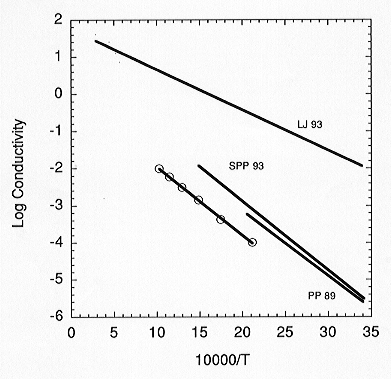

Laboratory electrical conductivity measurements at high pressures and temperatures are essential in the endeavour to constrain mantle mineralogy based on observation of Earth's geomagnetic signal. The difficulties associated with determining the electrical conductivity of high pressure phases like (Mg,Fe)SiO3 perovskite can partly be attributed to the small sample volumes resulting from in their syntheses. Attempts to determine perovskite electrical conductivity have been made in diamond anvil cell devices under pressures and temperatures within its stability field. Results from these studies, however, are not in very good agreement, most likely due to poorly controlled experimental conditions such as temperature homogeneity, cell geometry, and the possible presence of other minority phases which might influence the total conductance of the sample. The objective of this study was to utilize the multianvil apparatus to provide an independent measure of the conductivity of the lower mantle two-phase assemblage perovskite and magnesiowüstite. One very important advantage of this method is that it is utilizes much larger sample volumes compared to a diamond anvil cell, allowing for much more careful sample characterization.
So far, attempts to measure the electrical conductivity of a perovskite-magnesiowüstite assemblage within its P,T stability field using the multianvil apparatus have not been successful. Significant current leakage between the sample circuit and heating furnace has consistently resulted due to the small volume of the octahedral assembly (10 mm edge length) required for these very high pressure experiments. To circumvent this problem, we prepared a perovskite-magnesiowüstite sample, transformed from San Carlos Olivine (Mg1.8Fe0.2SiO4) in a 10 mm octahedron at 25 GPa and 1600°C, for measurement in a larger octahedral assembly (14mm) to be conducted at a lower pressure of 16 GPa. The 14 mm assembly contains a LaCrO3 stepped furnace providing the additional advantage of a reduced temperature gradient (~70°C/mm at 1450°C) across the 0.6 mm long sample. The measurement was carried out at temperatures up to 700°C in order to determine its temperature dependence while still being low enough to take advantage of the slow kinetics of its back-transformation to ringwoodite and/or wadsleyite. Analyses of the sample by powder X-ray diffraction before and after the measurement show no differences and are consistent with a two-phase aggregrate of perovskite and magnesiowüstite.
Data plotted as log conductivity vs. 1/T are shown in Fig. 3.4-1 and
are compared with values for other perovskite-magnesiowüstite assemblages
determined in diamond anvil cell experiments. Overall, our results indicate
lower conductivities compared to the diamond cell studies where there is
overlap in temperature.
 |
Fig. 3.4-1: Log conductivity versus reciprocal temperature for a perovskite-magnesiowüstite (Mg0.9Fe0.1)2SiO4 assemblage at 16 GPa measured in-situ using a multianvil apparatus (data are indicated by line through open circles). For comparison, other conductivity data for similar assemblages measured using diamond anvil devices are shown. |
This difference may be related to a pressure effect, as previous studies
have indicated that the activation volume is slightly negative. Least squares
fitting our data to the equation  =
= oexp(-Ea/kT)
yields an activation energy of 0.37 eV, in good agreement with Peyronneau
and Poirier's results, and a
oexp(-Ea/kT)
yields an activation energy of 0.37 eV, in good agreement with Peyronneau
and Poirier's results, and a  o
value of 0.76. This value is low compared to the
o
value of 0.76. This value is low compared to the  o
value estimated for the lower mantle based on geomagnetic observations.
We point out, however, that at temperatures up to 700°C conduction
likely remains extrinsic. The intrinsic conduction regime, where there
is a stronger temperature dependence, should occur at higher temperatures.
o
value estimated for the lower mantle based on geomagnetic observations.
We point out, however, that at temperatures up to 700°C conduction
likely remains extrinsic. The intrinsic conduction regime, where there
is a stronger temperature dependence, should occur at higher temperatures.

Tel: +49-(0) 921 55 3700 / 3766, Fax: +49-(0) 921 55 3769, E-mail: bayerisches.geoinstitut(at)uni-bayreuth.de
 Previous page
Previous page